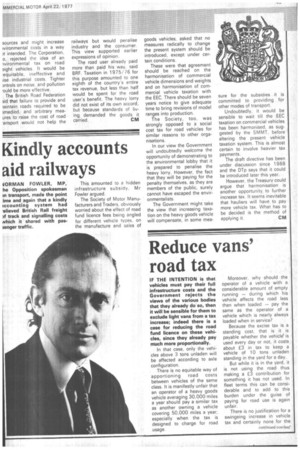Reduce vans' road tax
Page 45

Page 46

If you've noticed an error in this article please click here to report it so we can fix it.
IF THE INTENTION is that vehicles must pay their full infrastructure costs and the Government rejects the views of the various bodies that they already do so, then it will be sensible for them to exclude light vans from a tax increase; indeed there is a case for reducing the road fund licence on these vehicles, since they already pay much more proportionally.
In that case, only the vehicles above 3 tons unladen will be affected according to axle configuration.
There is no equitable way of apportioning road costs between vehicles of the same class. It is manifestly unfair that an operator of a heavy goods vehicle averaging 30,000 miles a year should pay a similar tax as another owning a vehicle covering 50,000 miles a year; especially when the tax is designed to charge for road usage. Moreover, why should the operator of a vehicle with a considerable amount of empty running — during which his vehicle affects the road less than when loaded — pay the same as the operator of a vehicle which is nearly always loaded when in service?
Because the excise tax is a standing cost, that is it is payable whether the vehicle' is used every day or not, it costs about £3 in tax to keep a vehicle of 10 tons unladen standing in the yard for a day.
But while it is in the yard, it is not using the road thus making a £3 contribution for something it has not used. In fleet terms this can be considerable and to add to this burden under the guise of paying for road use is again unfair.
There is no justification for a swingeing increase in vehicle tax and certainly none for the. imposition of an extra amount to cover social costs.
CM's suggestion is to abolish the excise tax and increase fuel tax to relate it to actual expenditure on roads so that tax paid is related wholly to road usage. The tax would be directly related to vehicle weight, size and engine condition and actual mileage. The operator would be paying for what he used as he used it. It could be argued that operators who used noisy or dirty vehicles.. would be paying a social tax through increased fuel costs.
The method of collection would result in a reduction of civil service tax collectors and a saving in public expend iture. CM
damage caused by heavy vehicles is directly related to axle .weights. It is argued that it is the goods vehicle with few axles in relation to its weight which contributes least to the infrastructure costs.
There is no suggestion that an increase in permitted gross weight should result necessarily in a corresponding increase in permitted axle weights. A further axle would maintain the 10 tons per axle already permitted and increase the gross weight and payload. Therefore, the effect on road surfaces and the appearance of a heavier gross vehicle would be unaltered.
There would be other advantages and one, at least, would appeal to the environmental lobby.
An increase in payload would result in fewer heavy vehicles being required to move the same amount of traffic. Reducing the number of heavy commercial vehicles on the road, would also result in fuel savings — a matter close to the heart of every government.
The move would make t British haulier more cornpetiti with his Continental count part, especially for traf between EEC memb countries.
The FTA has estimated ti savings in transport and eneri costs to be in the region of 1 per cent. In financial terms tlis astronomical.
This measure would sure appeal to the vehic manufacturers. They alreat market vehicles designed ft increased gross weights thouc, they are operated at the preset 32-ton limit.
CM urges the Government 1 include in its projected WhiPaper that permitted gro5. vehicle weights should increased from the preser 32-ton limit to 40 tons, bt with no increase in axl weights.
The proposed improve vehicle inspection and regul tion system would go some wa to counter the pretests whic would undoubtedly result. Cr




















































































